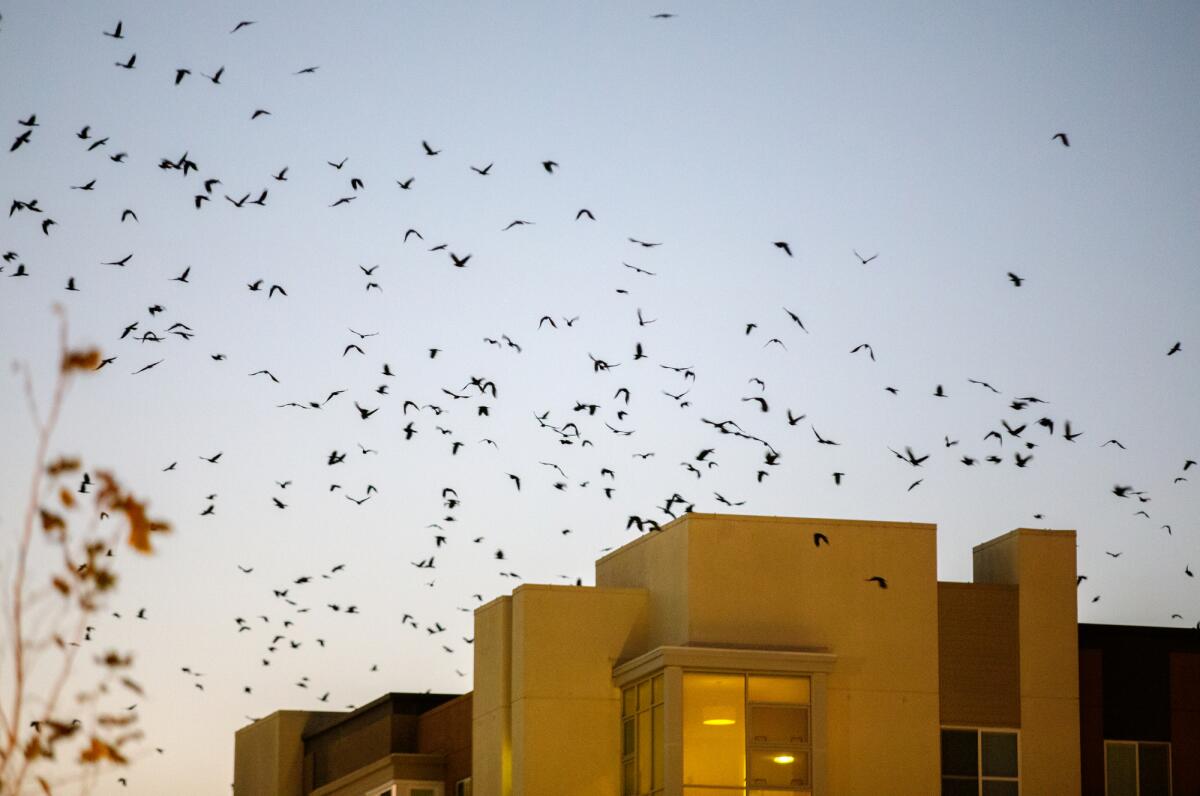Northern California city turns to lasers in attempt to chase off crows

- Share via
The city of Sunnyvale in Northern California recently employed a secret weapon to shoo away thousands of nesting crows from its popular downtown area: lasers.
It appears to be working. The crows are disturbed and dispersed by the intense beam of light.
But it turns out the Federal Aviation Administration also doesn’t like lasers.
In a recent letter, the FAA reminded city officials that Sunnyvale is located near four airports: Mineta San Jose International, Moffett Field, Palo Alto and San Carlos airports. Planes landing and taking off fly at low altitudes near the Silicon Valley community.
“Lasers are an aviation safety hazard to flight crews,” FAA regional administrator Raquel Girvin wrote in a letter last month to city officials. “Lasers may blind a pilot. Our office alone receives approximately one laser complaint daily solely regarding hazards to flight crews.”
City officials said they were aware of the FAA guidelines, and noted that there is only one city employee on crow patrol armed with a single $20 hand-held laser pointer. Each day around dusk, the worker briefly shines a green light into the canopy of trees.
They said the city followed guidelines from the Humane Society of the United States, the Audubon Society of Portland, Ore., and officials in Rochester, Minn., which has a similar crow patrol program. Sunnyvale’s pilot program is slated to end next week, after which time the city will review its success. The FAA in a statement said they will be “closely monitoring for laser-strike reports” from pilots flying around the city over the next few months.
In the last few years, roosting crows have massed in the thousands around Plaza del Sol in Sunnyvale, the city square that houses cafes, restaurants and a few software companies.
Outdoor eating during the pandemic has become the norm, but so have bird droppings fouling sidewalks, Mayor Larry Klein said.
“Crows roosting overnight in trees creates quite a bit of a mess in downtown,” Klein said. “We’ve had to spray wash over the last year and a half: the sidewalks, the parks, the streets downtown.”
Not to mention the cawing.
The city has tried other novel approaches to chasing away the crows. Previously, it installed reflectors and hired a trained falconer to try to banish the birds. Neither of those really did the trick, Klein said. Then came the crow effigies and boomboxes that play the sound of crows in distress.
“Just seeing what the streets look like, what the sidewalks look like, and hearing from some of our residents, all of it has definitely helped,” Klein said.
The spectacle of thousands of crows returning to their roosts around dusk is a noisy affair, but also a marvel of nature to some.
“It’s like clockwork, every day,” Briah Falmoe, general manager at Philz Coffee near Plaza del Sol said. “Huge swarms of them pass through. Customers think it’s kind of cool to watch.”
Sunnyvale’s crow saga was first reported by the Mercury News, but the city is not alone in its struggle.
Large swarms of crows blot out the sun across the San Francisco Bay Area and in the Central Valley, said Steven Beissinger, a professor of ecology and conservation biology at UC Berkeley. Crows amass in most major urban location where there is an abundance of food, he said.
Nearly 20 years ago, Californians witnessed a mass die-off of crows, magpies and jays due to the West Nile virus. The mosquito-borne virus had spread across the United States with infected migrating birds. But the impact to crows was short-lived, Beissinger said.
“They have just really come back,” Beissinger said. “And I think they’re probably more abundant than they were before. That’s just my sense.”
Sunnyvale’s laser approach might be effective, Beissinger said, but eventually the crows become someone else’s problem as they leave to roost elsewhere.
U.S. Fish and Wildlife Service spokesperson Jane Hendron said green lasers do not violate any federal laws. But some point out there are other possible deterrents, such as using trained dogs to chase away birds from airports or the careful placement of strips of bird spikes to discourage congregating.
There are also concerns that a laser could blind a crow, said Matthew Dodder with the Santa Clara Valley Audubon Society.
“We have provided a good habitat for the crows and they’re now making use of it,” Dodder said. “Lasers could very well be hurting this widespread species.”
Dodder thinks Sunnyvale’s approach goes too far. He said the problem should fly away with mating season, sometime around March.
More to Read
Sign up for Essential California
The most important California stories and recommendations in your inbox every morning.
You may occasionally receive promotional content from the Los Angeles Times.











